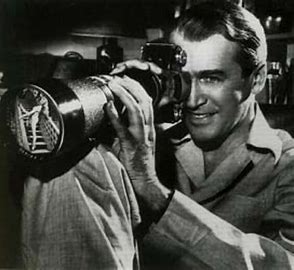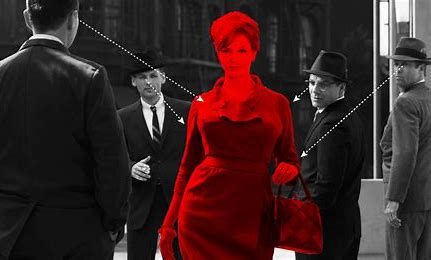
The concept of the “male gaze”, introduced by feminist film theorist Laura Mulvey in her 1975 essay “Visual and Other Pleasures“, has become a critical framework for understanding the objectification of women in visual media. The “male gaze” refers to the way visual arts, especially the cinema, often portrays women from a male, heterosexual perspective, positioning them as objects of desire and passive subjects for the male viewer. This not only influences how women are portrayed in film, but also in other forms of media, including music videos, advertisements, and magazines. By analysing the “male gaze” in these contexts, we can understand how it shapes the publics’ views on gender and power.
“Visual and Other Pleasures“
In Visual and Other Pleasures, Mulvey argues that mainstream cinema often centres the male perspective, positioning women as passive objects to be looked at, while men remain the active agents in the narrative. She uses the concept of “scopophilia” (meaning: pleasure in looking) to describe how audiences derive pleasure from the act of looking at women, whose bodies are often objectified and framed for male consumption. This theory applies to a wide range of media, where women are often depicted as visually appealing objects rather than fully realised subjects.
Pretty Woman (1990)

One clear example of the male gaze can be seen in Pretty Woman (1990) movie, a romantic comedy where the female protagonist, Vivian, is introduced as a prostitute whose transformation into a “respectable” woman is defined through her romantic relationship with a rich man. As Mulvey suggests, the camera lingers on Vivian’s body throughout the film, emphasising her attractiveness rather than her individuality or agency. In this narrative, Vivian’s worth is validated by her relationship with the male protagonist, Edward, reflecting the patriarchal notion that a woman’s value is dependent on male approval. The way she is seen through Edward’s eyes mirrors how the audience is encouraged to view her, focusing on her beauty and sexual appeal. This framing of women as objects to be desired and “possessed” by men reinforces traditional gender dynamics.
Mulvey’s analysis has sparked a significant body of feminist scholarship that critiques the representation of women in media. Many contemporary works seek to challenge the male gaze by subverting traditional gender roles and presenting more nuanced and empowered portrayals of women. For instance, movies such as Mad Max: Fury Road (2015) and Wonder Woman (2017) offer female protagonists who are not only central to the narrative but are depicted as strong, complex, and active agents in their own stories, challenging the passive, objectified roles typically assigned to women.
To Conclude,
the “male gaze” still has a strong influence in shaping the way women are represented in media. In many different forms of media, women are often framed as objects to be gazed upon and desired. By applying Laura Mulvey’s theory of the male gaze, we gain insight into how these portrayals reinforce gender inequalities and limit the agency of women in visual culture. However, ongoing efforts to challenge and subvert the male gaze in contemporary media offer hope for a more equitable and inclusive representation of women.
Reference
- Mulvey, L. (1975). Visual and Other Pleasures. Screen, 16(3), 6-18.


Your blog offers a compelling exploration of the male gaze, with Pretty Woman serving as a great example to illustrate Mulvey’s theory. I also appreciate your discussion of modern films like Mad Max: Fury Road and Wonder Woman, which highlight progress in subverting traditional gender roles. One suggestion might be to briefly touch on how social media platforms complicate the male gaze, as they both empower women to share their own narratives and sometimes perpetuate objectification. Over all, gooood job!!!
I really liked this blog post and think it was a great insight to the male gaze! You defined the theory, including the work from Mulvey, which gave a full perspective. I liked the use of a movie as a real example. Great job!
I really like your analysis of Pretty Woman. It’s clear that the film uses a supposed female perspective to depict a society controlled by men. A woman’s drive determines how she is portrayed in the movie. Allowing women to break free from dependence on men and become characters capable of solving problems on their own is what constitutes a good female perspective. Of course, I don’t like stories where women completely detach from men either, as such narratives become overly rigid and can fall into another extreme. Instead of focusing solely on portraying women’s strength, it’s better to create an intertwined dynamic where characters mutually rely on one another. Women can rely on men, but at the same time, men also rely on women. When characters of different genders have distinct, irreplaceable roles that are all significant, that’s what I consider a good, independent expression.
Hello,
Your blog post was really interesting. It introduced the concept of the male gaze by feminist film theorist and gave a background into the topic by associating the male gaze with the media. A lot of films portray women specifically in certain ways and this has affected society’s image or view of women as a whole. You gave an example by the form of a movie which was a great example and your personal opinion in the conclusion. All in all it was a great read!
Abdikarim
Your post is visually appealing, concise and clear, making it easy to follow. Focusing around pretty woman makes the post impactful because it is a well known movie and it was a good way to illustrate mulveys theory.